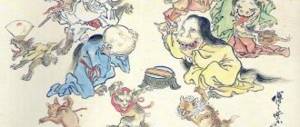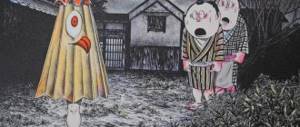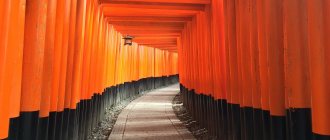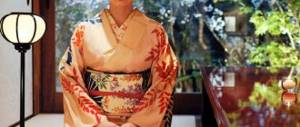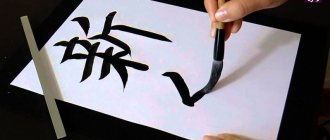Good afternoon friends! Since we started the topic of evil spirits, in this post we’ll talk about the horrors that haunt the Japanese. Every nation has its own horror stories, urban legends, forest evil spirits, ghosts and the like. I’ll try to collect all the Japanese horror in one place. Supernatural creatures of Japanese mythology are called yokai 妖怪, and there are so many of them that the list can be endless. One type of youkai is yurei 幽霊 - ghost, otherworldly spirit. They are scary because this species, unlike other characters of Japanese mythology, is closer to our perception and represents the spirit of dead people, that is, ghosts, ghosts, but more on that later.
Japanese mythology is very intricate and multifaceted, its origins were formed in ancient times and the first mention of youkai appeared in the first century. In the subsequent written monuments of Japan “Kojiki”, “Nihon Shoki”, “Shoku Nihongi” one can find mention of youkai. The close connection of Buddhism with the Shinto religion has given rise to a huge number of mythical and otherworldly creatures, which have no analogues in any mythology in the world.
Youkai are not only terrible and dangerous creatures, among them there are those who bring good luck. History tells that many Shinto gods - kami at different times passed into the state of youkai and returned back to the form of kami. I don’t dare talk about everyone, but the most prominent representatives will visit this page.
Kama-itachi
Kama-itachi.
Illustration from Kyoka Hyaku-monogatari, 1853. Image: Wikimedia Commons Kama-itachi is a Japanese weasel-shaped yōkai (evil spirit). Literal translation of MD Foster. The Book of Yokai: Mysterious Creatures of Japanese Folklore - "weasel with sickles." Tales of kama-itachi are popular in the Koshinetsu region of Japan. These creatures always appear in threes - it is believed that they are triplets. They are engaged in cutting off people's lower limbs. The sequence of actions is as follows: the first weasel knocks down the victim, the second removes the legs with sickles that grow on it instead of claws, and the third stops the bleeding and sews up the wounds.
But the most amazing thing is that the trio of kama-itachi, transported in the form of a dust devil, moves at about the same speed as the Flash in the DC Universe.
And it takes them less than a second to do the dirty deed.
Kama-itachi manage to carry out the amputation so that the victim does not feel any pain at all. It’s very nice that caring weasels take the time to patch up the injured person before flying away and taking his legs with them.
Moral: Don't go out during a dust storm.
Yamata no Orochi
8-headed dragon Yamata no Orochi
In the traditional tale, Yamata no Orochi was an 8-headed dragon with eight tails. His body was so huge that it could cover eight mountain peaks and valleys. He ravaged the surrounding villages and demanded tribute in the form of people to be eaten. Only the mythical hero Susanoo was able to defeat him with the help of cunning.
Konaki-diji
Konaki-diji.
Illustration from folklorist Kunio Yanagita's book Yōkai Dangi, 1956. Image: Public Domain Konaki-diji is a supernatural creature by T. Francis-Cheung. The Element Encyclopedia of the Psychic World: The Ultimate A-Z of Spirits, Mysteries and the Paranormal, which looks like a small child or even a baby, but with the face of an old man. True, he is always prudently positioned in such a way that his face can be seen only when it is too late to do something.
Konaki-diji sits on the side of some mountain path in deserted places and roars.
A random traveler or traveler, seeing an abandoned child, picks him up in his arms to console him. As soon as the konaki-diji is lifted off the ground, it suddenly acquires additional mass (plus 2-3 centners) and flattens the kind-hearted traveler.
Women especially suffer from this youkai. Firstly, they cannot pass by a sobbing baby. Secondly, the average Japanese woman has little chance of surviving after a konaki-diji falls on her. But a particularly strong samurai has a chance to survive, and in this case the yokai will reward him for his endurance.
Moral: Stay away from small children.
Shuten-dōji
Demon Shuten-dōji
According to legends, Kyoto once suffered greatly from the demon doji , who came down from the mountains and kidnapped women in the city to devour them. The emperor eventually sent a samurai named Minaomoto "Raiko" Yerimitsu and five servants to kill the demon. In the end, after a series of adventures and divine intervention, they managed to do it.
Osiroi-baba
Osiroi-baba.
Illustration from the book Konjaku Hyakki Shūi, 1780. Image: Wikimedia Commons The Ghost of T. Francis-Cheung. The Element Encyclopedia of the Psychic World: The Ultimate A-z of Spirits, Mysteries and the Paranormal in the form of a terrible, disgusting hunchbacked old woman. Her face is roughly covered in powder, and she holds a bottle of sake in her hand. Osiroi-baba walks the streets with an umbrella and a stick and looks out for beautiful young women.
When she finds one, she immediately runs up to her and in a soulful voice begins to convince her to buy some powder from her.
The naive girl agrees to take a sample, smears herself with powder, and her face falls off.
Moral: if you are a young beautiful woman and an intrusive cosmetics salesman approaches you, walk away silently.
Ittan-momen
Ittan-momen.
Drawing by Tosa Mitsunobi, 16th century. Image: Wikimedia Commons The Japanese have a belief that if any forgotten object lies for a long time (for example, 100 years), it will gain consciousness and turn into a youkai - tsukumogami. Ittan-momen is a sheet that has become intelligent.
This wild but cute ghost without a motor loves to swoop down on passers-by at night and strangle them.
There is a legend about L. Bush. Asian Horror Encyclopedia: Asian Horror Culture in Literature, Manga and Folklore, that this damned levitating sheet once almost strangled a samurai. But he managed to take out the wakizashi blade and cut the ghost. Ittan-momen disappeared, leaving bloody marks on the warrior’s hands.
Other legends mention that ittan-momen can befriend a person and even serve him if he manages to earn the trust of a ghost. True, no one knows what a flying piece of fabric can do for you.
This is because no one has yet managed to make friends with him, and in fairy tales this moment is tactfully avoided. So, if you find yourself in Japan and encounter an ittan-momen, you will have to test this theory yourself.
Moral: Don't hoard old things or they will try to kill you.
Buddhism vs Shintoism
Before talking about the Japanese world of evil spirits, it is worth saying a few words about the religious structure of the Land of the Rising Sun. Unlike European countries, in Japan, almost throughout the entire existence of the state, two religions of equal strength and popularity coexisted - Buddhism and Shintoism.
Naturally, they influenced each other, and the interaction of Buddhism and Shintoism had a fundamentally different character than, say, Christianity and paganism in Russia.
It is curious that both religions appeared in Japan at approximately the same time.
Buddhism, like the beginnings of Shintoism, came to the Land of the Rising Sun back in the 6th–7th centuries, although Shintoism finally took shape into a full-fledged religion a little later, by the 8th century. At the same time, he absorbed some elements of local beliefs. The relationship between the influence of Buddhism and Shintoism is spoken of, for example, in the ancient book “Nihongi” (720), which mentions Emperor Yomei (518–587), “who professes Buddhism and reveres Shinto.”
Utagawa Kuniyoshi
In general, the emperor’s position in matters of faith was decisive, and religion, of course, more than once became a political weapon of opposing elites. For example, the very formation of Shintoism was closely connected with the primary centralization of power, when the “proto-Japanese” state of Yamato appeared, renamed Japan in 670.
Empress Genmei (661–721), one of the first rulers of the new country, made a lot of efforts to “restore order” to Shintoism. Under her rule, in 712, work on the famous chronicle “Records of Ancient Deeds” (“Kojiki”) was completed, and in 720, work on the “Annals of Japan” (“Nihon Shoki”) was completed.
These two extensive works are key texts for Shintoism: they contain not only myths about the origin of the world, but also historical information about Japan and its rulers, who descend directly from the gods.
It is worth noting that the speedy completion of these works was extremely important for Empress Genmei: it was not easy for a woman at the head of state to justify her right to the throne, and this difficult situation was mitigated thanks to religion, because one of the dominant deities, according to Shintoism, is the sun goddess Amaterasu , ancestress of the imperial family.
The action in "Kojiki" develops in both real and fictional worlds: on the Plain of High Heaven, the abode of the gods, and in the Land of Darkness. The Land of Darkness is the Japanese version of hell (Yemi), but it is not nearly as elaborate as the ancient Greek kingdom of Hades or, especially, the Christian hell. The Land of Darkness may not be the most joyful place, but it is devoid of such a negative connotation - primarily due to the fact that the division between good and evil in Shintoism is not at all as obvious as in the monotheistic religions familiar to us.
Unlike the Shinto concept of hell, in the Japanese version of Buddhism, the afterlife has a much more thoughtful and holistic concept, although this was not without the influence of folk mythology. The Buddhist underworld is called Jigoku and is located across the Sanzu River, which has about the same meaning for hell as the Styx in ancient Greek mythology, separating two worlds - the living and the dead.
Each “recruit” will have to overcome Sanzu: people with good karma will do it on a convenient bridge, and those with bad karma will do it by swimming. All sorts of ugly monsters and dragons will be waiting for them in the water, who will not miss the opportunity to tear something from the sinner’s body.
As for those whose karma is in balance, they will have to ford the river - it is not as pleasant as walking across a bridge, but at least they will not have to encounter infernal creatures.
The matter doesn't end there. On the opposite bank of the river, a person is met by an elderly couple of ghosts: the old woman Datsue-ba and the old man Keneo - they are dressed in white robes, like all the dead. The first takes off the clothes of the arriving people, and the second hangs them on tree branches in order to assess the severity of the sins the person has committed.
Depending on the results, the “recruit” will face consequences: happy and not so happy. If everything is bad, then they begin to punish him right away: they can break his fingers, tie him up in an uncomfortable position, or tear out some organ.
In any case, the next stage is a meeting with the Great King Emma (or, for women, with his sister) - the supreme ruler of the underworld, under whose command are entire legions of “they”, Japanese demons, which will be discussed in more detail below.
Toriyama Sekien
Emma is usually depicted as a huge red-skinned man with a red face, bulging eyes and a crown on her head. It determines what kind of punishment a person will serve, and there is a great choice here: in total there are 8 worlds of cold hell and the same number of hot hell.
In each of them, the victim is tormented in its own way: placed in an icy valley or, conversely, on hot ground. Naturally, one cannot do without suffering, cutting a person into pieces, dousing him with molten iron, etc. By the way, the sinner will have to stay in hell for a long time: the terms of punishment are sometimes calculated in millions of years.
However, let us return to the question of rivalry and the development of religions in Japan. Under the same Empress Genmei, an official set of Shinto holidays was also created and legitimized, and 200 years later - in 947 - Engishiki was written, a document containing detailed instructions on how to correctly perform certain Shinto rituals and how to conduct religious ceremonies. And in 1087, a list of temples supported by the imperial family was approved.
Despite such close attention of Japan's top officials to Shintoism, Buddhism nevertheless became the state religion in the 9th century. It is noteworthy that back in the 8th century, Buddhists in Japan became so strong that some monks even occupied important government posts, and in 769 one of them almost carried out a coup.
The monk Doke was a favorite of Empress Koken (718–770), whom he once cured of an illness and tried to persuade her to make him ruler of the country. His plans were not destined to come true: the empress had a vision that power should not be transferred, but Doke did not have a second attempt: Koken died in 770, after which the frightened nobility sent the monk away from Nara, the then capital of the state, and forbade women to continue to occupy imperial throne - to avoid influence on government decisions by potential favorites.
It is interesting that the recognition of Buddhism as the state religion did not lead to a bloody clash between Buddhists and Shintoists, although a significant part of the population was dissatisfied with this state of affairs. People were especially irritated by the fact that “Buddhist representations” were opened at many Shinto shrines.
The fact is that in Shintoism the most important representative of the “other” world are kami - spiritual entities. They inhabit the whole world, people turn into them: after death, a person becomes a violent spirit of Aratama, then, after some time, he turns into a calmer spirit of Nigitama, and after that, 33 years later, he unites with the souls of his ancestors, turning into kami category - the Japanese dedicated temples to especially powerful kami.
In these temples, representatives of Buddhism began to hold their prayer services, saying that the kami were sinful spirits, and turned to them with a request for purification. Naturally, such treatment of the national religion caused a reaction from people.
Shoki and two demons.
Kawanabe Kyosai Beginning in the 13th century, many Japanese thinkers began to insist on the primacy of Shinto, and Kanemoto Yoshida, a 15th-century Japanese priest, came up with the slogan: “Kami is primary, Buddha is secondary.” Taking into account the fact that the Japanese took foreign gods, including, for example, Indian ones, as a type of kami, such an approach was logical and enjoyed some popularity. Around the same time, the treatise “Jinno Shotoki” appeared, written by Kitabatake Chikafusa: the text asserts not only the primacy of Shintoism, but also, based on this thesis, the chosenness and exclusivity of Japan, which is ruled by the emperor, in whose body the kami live, is affirmed.
All this eventually caused a surge of interest in Shinto, so that the 17th–18th centuries can be called the era of the Renaissance of Shinto: artists, writers, and thinkers turned to Shinto as the focus of the national spirit of Japan. Religion becomes what distinguishes the Japanese from all other peoples; it becomes a source of pride.
It is quite logical that Emperor Meiji (1852–1912), who during his reign transformed Japan, making it a powerful modern state, did not fail to use Shinto as a centralizing and unifying force. It was he who made Shinto the state religion, thus concentrating in his hands not only secular, but also religious power as the representative of the gods on earth.
The final point in the dispute between Buddhism and Shinto for the imperial favor was put by the Americans, under whose pressure Japan adopted the Constitution of 1947 - in it the emperor lost his divine status, which means that Shinto and Buddhism again found themselves in an equal position.
It is interesting that today the Land of the Rising Sun is in a curious situation: on the one hand, literally the entire life of the Japanese is permeated with Shinto rites and rituals, and on the other, the majority of the population treats these customs as an integral part of national traditions, and not as a religion. And therefore, not everyone considers themselves Shintoists: thus, the merging of religion and national character in Japan has gone further than in any other country - it should be noted that many traditions of Buddhism have also become part of the people's “blood and flesh.” For example, the same famous Obon, a three-day holiday of remembrance of the dead, is the most important religious ritual not only for local Buddhists, but for all Japanese.
Kasa-obake
Kasa-obake.
Illustration from the collection of the International Research Center for Japanese Studies. Image: Public Domain Another variety of tsukumogami. An umbrella that has been lying around unattended for 100 years turns into a kasa-obake. He grows one leg, two arms, an eye and a long tongue and is sent to MD Foster. The Book of Yokai: Mysterious Creatures of Japanese Folklore on its own.
Doesn't sound very dangerous, right? You're wrong, in Japan even an umbrella will try to kill you.
If you see an umbrella standing alone in the dark on a rainy night in the Higashiuwa area of Ehime Prefecture, run. Because if he looks at you with his only eye, you will be paralyzed.
In addition, sometimes the demonic umbrella grabs people with the claws on its only leg and, driven by a strong wind, rises into the sky and flies away with the victim in an unknown direction.
Moral: it's time to run headlong to sort out the contents of the closet.
Tsuchigumo
Tsuchigumo.
Illustration by Yoshitoshi Taiso, 1839–1892. Image: Wikimedia Commons Once upon a time, the word tsuchigumo (“earth spider”) was used to describe the tribes of the indigenous inhabitants of the Japanese islands, who stubbornly refused to obey the sun-like Nihon emperor. But over time, the barbarians were conquered, but the demonic image remained in folklore.
Tsuchigumo is a terrible youkai with the body of a tiger, the limbs of a spider and a terrible face, in comparison with which any European demon looks quite cute and even cute. These monsters inhabit G. Kenkyūsha. Nihon no yōkai no nazo to fushigi in the vicinity of Mount Yamato Katsuragi. They feed on unwary travelers. Although, strictly speaking, they also occasionally use cautious ones.
One day, one samurai dragged himself to Mount Yamato, apparently to visit the temple there and meditate while admiring the mountain sakura. On the way, he met a tsuchigumo spider. The monster tried to weave a web around the warrior, but he silently pulled out a katana and cut the arthropod into two halves. Exactly 1,990 skulls fell out of the tsuchigumo’s belly—the samurai was not too lazy to count.
See, these Japanese legends are true. Otherwise, would the storytellers give such exact numbers?
When the dead youkai fell to the ground, thousands of small spiders scattered from his sides in all directions. The samurai followed them into their lair, katana at the ready, although any sane person would only go into such a place in an OZK suit and with a flamethrower. In the spider's hole, the warrior found 20 more skulls.
Moral: Spiders are disgusting and dangerous.
How to say in Japanese - feelings and emotions expressing fear
Between reading creepy stories, let's friends remember the words that fit the moment. These Japanese words can be used when you are feeling terrified to communicate your emotions:
- The simplest and most common word from the horror category is 怖い / こわい / kowai - scary, frightening. This word is used when one is afraid of someone or something. Moreover, this word can be scary if a linguistic error is made. We remember very well that in Japanese a word is both pronounced and written (and vice versa). It is not permissible to replace sounds during pronunciation, as is customary in the Russian language. Moreover, there are many words in which, when replacing one sound in a word, a diametrically opposite meaning appears. For example, they wanted to say something nice to a girl: 可愛い / かわいい / kawaii - pretty, sweet, but they faltered and said - こわい / kowai - scary, I think yes, the consequences will be terrible.
- 恐ろしい / おそろしい / osoroshii - terrible, terrible, ominous. Example: 昨夜恐ろしい夢を見ました。/ Sakuya osoroshī yume o mimashita. — Last night I had a terrible dream.
- when, after reading scary stories, you go to drink tea and trip over a cat in the dark, you will shudder with horror, it will be ぞっとする / Zotto suru (tremble, shudder)
- In other words, you can describe your fear and horror: 背筋が凍る / せすじがこおる / Sesuji ga kōru - the spine is frozen, that is, it is scary to the point of numbness. Or horror that clots the blood - ちもこおる / Chi mo kooru
- 恐怖 / kyo:fu fear, dread. 恐怖する / kyo:fusuru - to be scared. 恐怖症 / きょうふしょう / Kyōfushō, and this is already a phobia. These words explain psychological, irrational fear.
- ぐろい / Guroi - disgusting as hell, so much so that it bothers you.
- another way of saying that fear gives you goosebumps 鳥肌が立つ / とりはだがたつ / Tori hada ga tatsu
- Probably everyone has at least once experienced a situation (at least in a dream) when, numb with fear, your legs become weak and it is impossible to move. In Japanese, this state can be expressed by the phrase 足が竦む / あしがすくむ / Ashi ga sukumu - legs numb with fear.
- 肝を冷やす / kimoohiyasu - to be terrified. 肝 / きも - translated into Russian - liver (organ), 冷やす - to freeze. As an important organ, the liver is often used in Japanese idioms to show how serious a situation is. By saying this phrase you are showing how scared you are to do something.
- 忌まわしい / Imawashī - sinister, disgusting.
Sirime
Sirime.
Image: Njadaka1/Wikimedia Common Time for a peculiar Z. Davisson. Yurei: The Japanese Ghost of Japanese humor. Long ago, a certain samurai walked at night along the road to Kyoto. Walking around at night in the wilderness, as you understand, is a very bad idea - especially in Japan. But it is not proper for a warrior to bother his mind with such trifles. A samurai has no goal, only a path.
Suddenly he heard people behind him asking him to turn around. The warrior did so and saw a strange man in a kimono. This exhibitionist immediately turned his back to the samurai, took off his clothes and bent over.
And then the warrior saw a huge sparkling eye.
Offended by such an indecent gesture, he immediately pulled out a katana and hacked the insolent man to death on the spot... no. In fact, this unworthy coward, unable to follow the Busi code, simply ran away.
Sirime literally translates to “eyes and buttocks.” Why is this youkai acting like this? Probably just because he can afford it.
Moral: don't mess with tramps. And don't look back.
Akkorokamui
Akkorokamui - Loch Ness monster in Japanese
Just as other cultures believe in the Yeti or the Loch Ness monster, in Japan they believe in Akkorokamui , a giant 110-meter octopus. In the early 1900s, representatives of the Ainu, an indigenous group of Japanese, claimed that the beast attacked three fishermen. After this, the Ainu always take weapons with them in boats. Even today, some people claim that the huge octopus is still alive and well. Luckily, given its bright red color and enormous size, it is visible from afar.
Nurarihyon
Nurarihyon.
Illustration from the Harry F. Bruning Collection of Japanese Books and Manuscripts. Image: Wikimedia Commons Nurarihyon is MD Foster's ayakashi. The Book of Yokai: Mysterious Creatures of Japanese Folklore, the supreme demon yokai. His default appearance is that of an extremely ugly monk with a huge head. However, nurarihyon has a superpower: when he enters someone’s house, he begins to look and behave just like the owner of this home.
Having got inside while the owners are away, Nurarihyon begins to use the home as if it were his own. For example, he drinks tea, picks up things he likes, and even perhaps signs up for paid subscriptions to streaming services at your expense. He calmly tells his neighbors that the trip simply didn’t take place, that’s why he’s at home.
Just imagine: any friend you come to visit may not be a person you know well, but a gloomy supreme youkai.
Perhaps it is because of Nurarihyon's antics that the Japanese are so courteous and obsessed with formality and decency. Well, or it’s all the fault of the samurai, who loved to cut off heads for any sideways glance. And this greatly contributes to the development of politeness among the survivors.
Moral: be extremely careful even with those you have known for a long time. You never know.
Sazae-oni
Sazae-oni.
Illustration from the book Gazu Hyakki Tsurezure Bukuro, 1784. Image: Wikimedia Commons European culture created mermaids - sea seductresses who destroy sailors yearning for female warmth. Or they grow legs and marry princes - depending on their luck. Japanese culture gave birth to sadzae-oni MD Foster. The Book of Yokai: Mysterious Creatures of Japanese Folklore. And believe me, the eastern counterparts of mermaids are much more severe than the western sea maidens.
Literally, sadzae-oni translates as “devil clam.” If a sea snail lives a very, very long life, sooner or later it will grow into a huge slug-like creature that can turn into a beautiful girl. This is sadzae-oni.
Another option: if a beautiful girl unrequitedly loves a sailor and drowns in the sea out of grief, she will transform into a terrible mollusk. And he, in turn, will, if necessary, turn back into a girl. I hope you are not confused.
One day, a gang of Japanese pirates were sailing on their ship through the night and saw a woman drowning in the sea. They saved her, and in gratitude, the beauty invited them to spend time together. And the next morning, the tired robbers discovered that their testicles had disappeared.
The versions of the story vary: in some, the sadzae-oni bit them off, in others, she tore them off. Why the pirates did not notice what had happened until the morning, one can only guess - perhaps they overdid it with strong drinks.
The pirates, in a rage, threw the seductress overboard. But then they realized that they had gotten carried away and swam after her, begging the sadzae-oni to give them back their courage.
The sea maiden, who took on her usual form of a monstrous slug, willingly agreed to return the stolen goods for a ransom. The filibusters had to give her all the stolen gold, and she returned the severed body parts to them in their place.
The legend contains a play on words: in Japanese these most vulnerable parts of the male body are called kin-tama, “golden balls.” So the mermaid exchanged gold for gold.
If you think that the sadzae-oni who robbed the bandits distributed the treasure to those from whom the pirates took it, nothing of the kind. This is followed by fairy tales about Robin Hood, and here we have a harsh story from feudal Japan.
Moral: Avoid relationships with strangers, especially if you find them at sea.
Gasadokuro
Gasadokuro.
Illustration by Utagawa Kuniyoshi, 1844. Image: Wikimedia Commons If the dead are not removed from the battlefield or people are buried in mass graves, their bones will eventually be collected in MD Foster's gasadokuro. The Book of Yokai: Mysterious Creatures of Japanese Folklore. It is a huge skeleton made up of normal sized skeletons. It is known that Gasadokuro is exactly 15 times larger than an ordinary person, and its height is 27 meters.
Don’t ask where the Japanese get the exact numbers, just take it as a given.
The very first tales of gasadokuro go back to K. Friday. The First Samurai: The Life and Legend of the Warrior Rebel, Taira Masakado to the 10th century. Since the monster appeared from the remains of those who died from war, epidemics or famine, its character, as you understand, is not very pleasant. Gasadokuro hunts lonely travelers, and you can hear about his approach from afar, because his teeth chatter all the time.
But in general, the skeleton may not be evil in itself - it’s just that his life is hard. Sometimes he even shows friendliness towards those who have done him a favor. There is one tale from the book Nihon Ryōiki, written between 787 and 824. One day a certain Japanese man was walking at night (bad idea, very bad idea) through the field of Bingo Province in Hiroshima Prefecture and heard monstrous howls: “Eye! My eye hurts!”
A reasonable person would have immediately run away, but not this samurai. He found a giant skeleton with a bamboo shoot sticking out of its eye socket, took out the stem and treated Gasadokuro to boiled rice. Impressed by his kindness, he told the hero the story of how he died and generously rewarded the warrior. And then he fell apart, finding peace.
Moral: Be kind and help others. Or run away immediately, otherwise you will be eaten.
Otorosi
Otorosi - a monster that eats people
If a beast attacks people and devours them alive, it does not necessarily mean that it is evil. For example, otoroshi (also known as Otoroshi, odoro-odoro, or odoro-gami) liked to take up residence in Japanese shrines. These long-haired creatures with ogre-like faces waited for people at the top of the gate leading to the sanctuary, and then pounced on them and devoured them. It would seem, what could be good about such a monster? It turns out that he only attacked bad people.
Katakirauwa
"The Emperor and the Boar", Ginko Adachi, 1896.
Image: Wikimedia Commons Have you noticed that all the Japanese ghosts are rather unusual characters? Well, compared to them, Katakirauwa looks rather modest. These are the ghosts of MD Foster's black pigs. The Book of Yokai: Mysterious Creatures of Japanese Folklore, which have one ear and cast no shadows, but otherwise look pretty decent. True, there is one problem with them.
If the spirits manage to run between your legs, they will devour your soul, and one of the piglets will inhabit your body.
A 27-meter skeleton is better, right? At least you can see it from afar.
Moral: watch your step.
